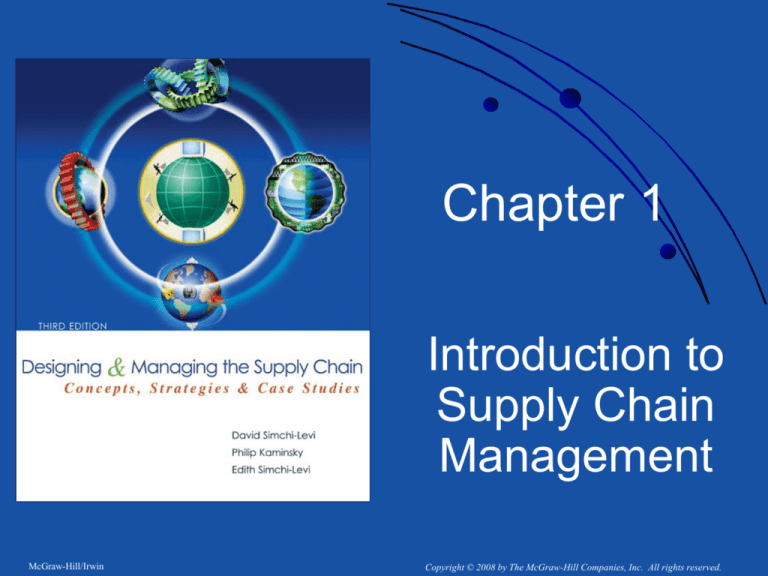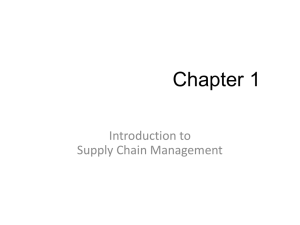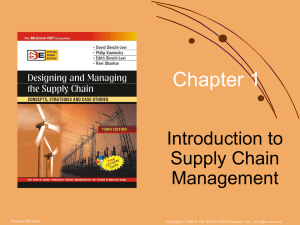
Chapter 1
Introduction to
Supply Chain
Management
McGraw-Hill/Irwin
Copyright © 2008 by The McGraw-Hill Companies, Inc. All rights reserved.
What Is a Supply Chain?
Flow of products and services from:
•
•
•
Raw materials manufacturers
Intermediate products manufacturers
End product manufacturers
Wholesalers and distributors and
Retailers
Connected by transportation and storage
activities
Integrated through information, planning,
and integration activities
Cost and service levels
1-2
1.1 What Is Supply Chain
Management?
Supply chain management is a set of
approaches utilized to efficiently integrate
suppliers, manufacturers, warehouses,
and stores, so that merchandise is
produced and distributed at the right
quantities, to the right locations, and at the
right time, in order to minimize system
wide costs while satisfying service level
requirements.
1-3
Two Other Formal Definitions
The design and management of seamless, valueadded process across organizational boundaries
to meet the real needs of the end customer
Institute for Supply Management
Managing supply and demand, sourcing raw
materials and parts, manufacturing and assembly,
warehousing and inventory tracking, order entry
and order management, distribution across all
channels, and delivery to the customer
The Supply Chain Council
1-4
PC Industry Supply Chain
Tracing back the screen you stare at for the bulk of your time.
1-5
Cisco’s Value Network
1-6
SCM Definition
Material Flow
Supplier
Converter
Distributor
Retailer
Source
Converter
Supplier
Distributor
Consumers
End-User
Value-Added Services
Funds/Demand Flow
Information Flow
Reuse/Maintenance/After Sales Service Flow
1-7
The SCM Network
FIGURE 1.1: The logistics network
1-8
Key Observations
Every facility that impacts costs need to be
considered
Efficiency and cost-effectiveness throughout the
system is required
Suppliers’ suppliers
Customers’ customers
System level approach
Multiple levels of activities
Strategic – Tactical – Operational
1-9
Other Related Observations
Supply chain strategy linked to the
Development Chain
Challenging to minimize system costs and
maximize system service levels
Inherent presence of uncertainty and risk
1-10
1.2 The Development Chain
Set of activities and processes associated
with new product introduction. Includes:
product design phase
associated capabilities and knowledge
sourcing decisions
production plans
1-11
1.2 The Development Chain
FIGURE 1-2: The enterprise development and supply chain
1-12
1.3 Global Optimization
Geographically dispersed complex
network
Conflicting objectives of different facilities
Dynamic system
Variations over time
Matching demand-supply difficult
Different levels of inventory and backorders
Recent developments have increased
risks
Lean production/Off-shoring/Outsourcing
1-13
Global Apparel Value Chain
Tracing back the dress you are wearing
1-14
1-15
Globally Dispersed Manufacturing
An Illustration: How Li & Fung Limited Might Make a Dress
Product Design
[Hong Kong]
Yarn Spinning
[Korea]
QC & Shipping
[Hong Kong]
Weaving
[Taiwan]
Stitching
[Indonesia]
Zippers+…
[Japan+…]
1-16
1.4 Uncertainty and Risk Factors
Matching Supply and Demand a Major
Challenge
REASONS
EXAMPLES
•Raw material shortages
•Internal and supplier parts
Boeing Aircraft’s inventory writedown of $2.6 billion
shortages
•Productivity inefficiencies
•Sales and earnings shortfall
•Larger than anticipated inventories
•Stiff competition
•General slowdown in the PC
Sales at U.S. Surgical Corporation
declined 25 percent, resulting in a
loss of $22 million
Intel reported a 38 percent decline
in quarterly profit
market
•Higher than expected orders for
new products over existing
products
EMC Corp. missed its revenue
guidance of $2.66 billion for the
second quarter of 2006 by around
$100 million
1-17
1.4 Uncertainty and Risk Factors
Fluctuations of Inventory and Backorders
throughout the Supply Chain
FIGURE 1-3: Order variations in the supply chain
1-18
1.4 Uncertainty and Risk
Factors
Forecasting is not a solution
Demand is not the only source of
uncertainty
Recent trends make things more uncertain
Lean manufacturing
Outsourcing
Off-shoring
1-19
1.4 Uncertainty and Risk
Factors
August 2005 – Hurricane Katrina
2002 West Coast port strike
Losses of $1B/day
Store stock-outs, factory shutdowns
1999 Taiwan earthquake
P&G coffee supplies from sites around New Orleans
Six month impact
Supply interruptions of HP, Dell
2001 India (Gujarat state) earthquake
Supply interruptions for apparel manufacturers
1-20
1.5 Evolution of Supply Chain
Management
Further
Refinement of
SCM Capabilities
SCM
Formation/
Extensions
JIT, TQM, BPR,
Alliances
Inventory Management/Cost
Optimization
Traditional Mass Manufacturing
1950s
1960s
1970s
1980s
1990s
2000s
Beyond
1-21
Progression of Logistics Costs
FIGURE 1-4: Logistics costs’ share of the U.S. economy
1-22
Composition of Logistics Costs
FIGURE 1-5: Total U.S. logistics costs between 1984 and 2005
1-23
1.6 Complexity: The Magnitude
U.S. companies spend more than $1 trillion in supplyrelated activities (10-15% of Gross Domestic Product)
Transportation 58%
Inventory 38%
Management 4%
The grocery industry could save $30 billion (10% of
operating cost) by using effective logistics strategies
A typical box of cereal spends 104 days getting from
factory to supermarket.
A typical new car spends 15 days traveling from the
factory to the dealership.
1-24
Complexity: The Magnitude
Compaq computer’s loss of $500 million to $1 billion in
sales in one year
Boeing’s forced announcement of write-downs of $2.6b
Laptops and desktops were not available when and where
customers were ready to buy them
Raw material shortages, internal and supplier parts shortages….
Cisco’s multi-billion ($2.2b) dollar write-off of inventories
in 2001-2002
Customers balked on orders due to market meltdown
1-25
Transactional Complexity
National Semiconductors:
•
•
Production:
– Produces chips in six different locations: four in the US, one in
Britain and one in Israel
– Chips are shipped to seven assembly locations in Southeast
Asia.
Distribution
– The final product is shipped to hundreds of facilities all over
the world
– 20,000 different routes
– 12 different airlines are involved
– 95% of the products are delivered within 45 days
– 5% are delivered within 90 days.
1-26
PC Value Chain
Performance of Traditional PC Manufacturer
1-27
PC Value Chain: Focus on Cost
Reduction
Performance of Dell Computers
1-28
Magnitude of Supply Chain Costs
Cost Elements of a Typical Trade Book
1-29
Magnitude of Supply Chain Costs
Example: The Apparel Industry
Cost per
Percent
Shirt
Saving
Manufacturer
Distributor
Retailer
Customer
$52.72
0%
Manufacturer
Distributor
Retailer
Customer
$41.34
28%
Manufacturer
Distributor
Retailer
Customer
$20.45
62%
1-30
Supply Chain: The Potential
P&G’s estimated savings to retail customers of $65 million
through logistics gains
Dell Computer’s outperforming of the competition in terms of
shareholder value growth over more than two decades by over
3,000% using:
Direct business model
Build-to-order strategy
Wal-Mart transformation into the world’s largest retailer by
changing its logistics system:
highest sales per square foot, inventory turnover and operating profit
of any discount retailer
1-31
1.7 Key Issues in Supply Chain
Management
Chain
Distribution Network Configuration
Inventory Control
Production Sourcing
Supply Contracts
Distribution Strategies
Strategic Partnering
Outsourcing and Offshoring
Product Design
Information Technology
Customer Value
Smart Pricing
Supply
Supply
Supply
Both
Supply
Development
Development
Development
Supply
Both
Supply
Global Optimization
Managing Risk and Uncertainty
Y
Y
Y
Y
Y
Y
Y
Y
Y
Y
Y
Y
Y
Y
Y
TABLE 1-1: Key supply chain management issues
1-32
1.8 Book Objectives and
Overview
• Inventory management
• Logistics network planning
• Supply contracts for strategic as well as commodity components.
• The value of information and the effective use of information in the supply chain.
• Supply chain integration.
• Centralized and decentralized distribution strategies.
• Strategic alliances.
• Outsourcing, off-shoring, and procurement strategies.
• International supply chain management.
• Supply chain management and product design.
• Customer value.
• Revenue management and pricing strategies.
• Information technology and business processes.
• Technical standards and their impact on the supply chain.
1-33
Software Packages
Computerized Beer Game
Risk Pool Game
Procurement Game
1-34
CASE: Meditech Surgical
Intent – diagnosis of supply chain
Business overview
Supply chain
Production planning
What’s wrong?
How to fix it?
1-35
Endoscopic Surgical
Instruments
Permits minimally invasive surgery
Market created in early 80’s, rapidly
growing
Old products continually updated and
replaced with new product introductions
1-36
Business Overview
National and Meditech split the market
Compete based on product innovations,
customer service, cost
National sells to physicians; Meditech sells
to material managers
Customer preferences change slowly
1-37
External Supply Chain
Hospitals
Domestic
Dealers
Part
suppliers
Meditech
Assembly
Meditech
Warehouse
Hospitals
Int’l
Meditech
Affiliates
1-38
Internal Supply Chain
Parts Inventory
2 - 16
weeks
Assembly
2
weeks
Bulk Inventory
Packaging &
Sterilization
FG Inventory
1
week
1-39
Production Planning
Annual
Forecast
Monthly
Revision
Transfer
Requirements
Monthly
Plan
MRP
Parts
Procurement
Plan
Weekly
Assembly
Schedule
1-40
Monthly
Plan
Production Planning
MRP
Order point;
Order quantity
Material
Plan
Parts Inventory
Assembly
Bulk Inventory
Packaging &
Sterilization
FG inventory
1-41
What’s Wrong?
Poor service for new product introductions
Poor forecasting?
Panic ordering?
And high FG inventory
1-42
What Is Going On?
Demand is quite predictable
Usage in hospitals is quite stable
Market share moves slowly over time
With each new product, dealer must build
inventory to fill pipeline
1-43
Why Did Meditech Think
Demand Was Unpredictable?
Poor information systems
No one looked at demand
No one had responsibility for forecast
errors
Tendency to shift the blame
Built-in delays and monthly buckets in
planning system
Amplifier in planning system
1-44
What to Do?
Recognize that demand is stable and
predictable
Establish accountability for forecast
Eliminate planning delays and/or reduce
time bucket
Alternatively, put assembly within pull
system and eliminate bulk inventory
1-45






